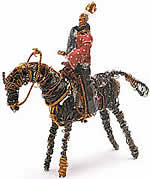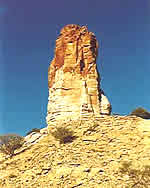Titjikala is a small community located about 110
km south of Alice Springs, and has a population of approximately
300 people, whose primary languages are Luritja, Arrernte or Pitjantjatjara.
The community is also known as Tapatjatjaka or Maryvale and the community art centre is called Tapatjatjaka Art and Craft Centre.

|
Arts and crafts have been produced by the community and
marketed through the local art centre. Art works include
paintings, batik, wood carving (punu), bush toys, ceramics, jewellery, T-shirts and fabrics.
Titjikala artists are also working on ceramics and wire
sculptures that include animal and bird representations
inspired by the surrounding environment.
The land for the traditional owners of the area stretches
from Horseshoe Bend through to Chambers Pillar, the Titjikala
community area, and then across to Mt Burrell, Mt Peachy
and to Mt Frank. |
 Cowboy by David Wallace
Cowboy by David Wallace |
These are traditional lands of Arrernte people. Several
families living in Titjikala are traditional owners of the area
around the community.
|
There are also people who have been living in the Titjikala
area for several generations, but whose family members
came from other areas. Their children, having been born
in this area, are connected to its dreaming. Consequently,
Titjikala has become the home to Arrernte, Luritja and
Pitjantjatjara people.
The eagle and the gecko dreamings are significant to
the Titjikala area and the Titjikala people. The country
surrounding Titjikala is characterised by red sand-hills
and desert oaks. Further to the south is the well known
scenic feature Chambers Pillar, which plays an important
role in the gecko dreaming. |
 Chambers Pillar
Chambers Pillar |
History of Titjikala Community
From the 1940s onwards families came to the Maryvale Station to work
as stockmen and as domestic helpers. The station owners provided rations
to the people who resided and worked on their stations.
Aboriginal people started settling in the area in the 1950s, when
a mission truck visited every six weeks. Families would work at the
surrounding stations as stockman, cameleers and domestic staff.
At this time the people still lived in traditional humpies. Water
was fetched from a well mainly by donkey wagons, but also by foot
or by camel. Children and women would travel back and forwards most
of the day collecting water from the well and carrying it to the humpy
area. The community obtained its food from rations from the station
(flour, salt and meat). People also collected bush tucker including
goannas, kangaroos, witchetty grubs, bush tomatoes and bush bananas.
Then in the early 1960s the community built their own sheds, much
like garages, with concrete slabs for flooring. At this time the station
laid piping from a good bore with the help of the Aboriginal people
to provide a tap near the new buildings. As part of the village a
church was built in the same garage style. In the 1970s the first
school was provided to the Titjikala people.
The community was originally a 200-hectare excision from the Francis
Well water reserve and the stock route. It is within the Maryvale
station pastoral lease, which was registered in 1978.
Titjikala community obtained freehold title to the excision in 1987
and in 1988 the Northern Territory Government gazetted the Titjikala
control Plan, which places certain restrictions on land usage and
development in the community.

Houses in Titjikala Community